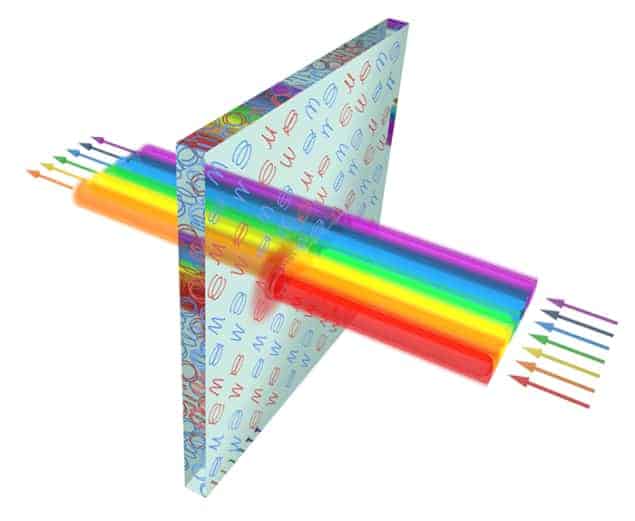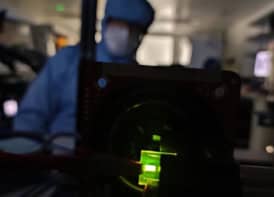
A “metasheet” that is extremely efficient at absorbing electromagnetic radiation in a very narrow band of wavelengths, while remaining transparent elsewhere in the spectrum, has been produced by researchers in Finland and Belarus. It was made by placing simple wire helices in strategic locations throughout the material, so that the helices absorb and dissipate energy contained in both electric and magnetic fields. The metasheet works for microwave radiation, and could be useful for making radiation detectors, telecommunications devices, energy-harvesting systems and even radar-cloaking devices. In principle, the design could also be modified to work for visible light.
The idea of a device that absorbs radiation at specific wavelengths is not new, but most existing devices reflect the unabsorbed radiation back to its source. This rules out many useful applications where transmission of the unabsorbed radiation is needed. To address this shortcoming, several groups have attempted to develop “Huygens’ metasurfaces”, which comprise arrays of sub-wavelength inclusions that scatter radiation only in the forward direction. If the resonant wavelength of the inclusions is chosen correctly, they can collectively dissipate radiation at a wavelength of choice. Radiation at other wavelengths is diffracted by the inclusions and its wavefronts are reconstructed to achieve transmission.
Previous designs have used different inclusions to absorb the electric and magnetic components of the incident radiation. While the different inclusions can be designed to have their central resonance peaks at the same wavelength, the absorption tends to fall away at different rates either side of the peaks. This prevents other wavelengths from being perfectly transmitted and leads to undesirable reflections. One solution is to use a material that is “bianisotropic”, which means that it can interact with both the electric and magnetic fields of the incident radiation. While this solves the problem of mismatched interactions away from the resonance peak, previous metasurfaces based on this principle could only observe one circular polarization of radiation.
Handy helices
Earlier this year, Viktar Asadchy and colleagues at Aalto University in Finland produced a “metamirror”. This device is transparent to wavelengths away from a resonant wavelength, while reflecting the resonant wavelength at a specific angle. The team has now extended this work to produce a surface that absorbs radiation at a specific wavelength and dissipates its energy as heat.
With these multifunctional structures, we can achieve completely amazing properties
Viktar Asadchy, Aalto University
The researchers made their resonators from helices of nickel-chromium wire, which is a dissipative material commonly used in electrical-resistance heaters. These helices are bianisotropic, which when excited by incident electromagnetic radiation become electrically polarized along the axis of the helix and magnetically polarized azimuthally. Because of its chirality – a helix can either twist with a right-handed or left-handed orientation – each helix is polarization sensitive, and therefore only absorbs light with a single circular polarization. The researchers therefore designed their metamaterial to include both right-handed and left-handed helices embedded in a plastic-foam substrate. This, they calculated, should produce metasheets that absorb light at a desired wavelength regardless of its polarization.
Manufacturing imperfections
They then tested the absorption of materials containing both single- and double-turn helical inclusions. At the resonance wavelength, they found that the single-turn helices absorbed 92% of the incident microwave radiation, whereas the double-turn helices absorbed 81%. These absorption figures, while impressive, are lower than the researchers’ theoretical predictions that single-turn helical arrays would absorb 96.5% of radiation and double turn 99.9%. The researchers attribute this difference to manufacturing imperfections.
The team is now looking to build on this and previous research to produce non-reflecting arrays of transmitters that can be stacked in layers. “For example, the first layer will transmit the wave in one direction or focus it at one point,” Asadchy explains. “The second layer, which will stay behind this first one, will focus a wave of another wavelength at another point. Then we can combine several layers of these transmit arrays because they are transparent at their non-operational wavelengths. “With these multifunctional structures, we can achieve completely amazing properties,” says Asadchy.
“I think that this work is very significant for our community because it points out a very new device, which is an invisible filter,” says Filiberto Bilotti of the University of Rome. He cautions, however, that while in principle the physics is scalable to work at shorter wavelengths, creating a practical material that works for near-infrared or visible light is “not that trivial” because the conductivity of metals drops at shorter wavelengths. As a result, a different strategy would be needed to create short-wavelength metasheets.
The metasheets are described in Physical Review X.



